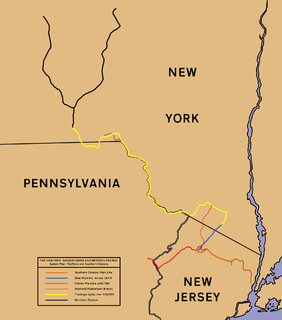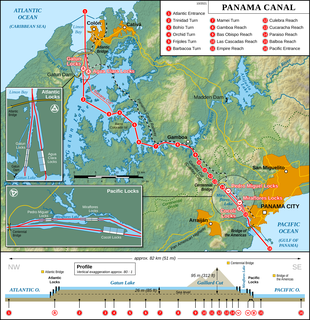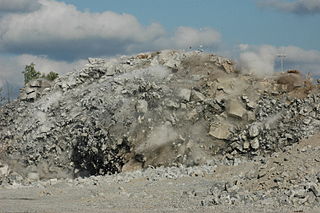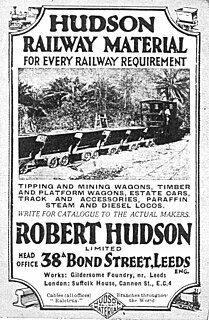
The Fairview Quarry at Fairview, Bergen County, New Jersey was operated around 1910 for several years by the Public Service Railway of New Jersey mainly for the production of track ballast.

The Fairview Quarry at Fairview, Bergen County, New Jersey was operated around 1910 for several years by the Public Service Railway of New Jersey mainly for the production of track ballast.
The quarry was located at The Palisades on the Bergen Turnpike, between West Hoboken and Hackensack. The quarry has been enlarged in 1911 from 1 acre to 25 acres, giving a visible supply of 1,500,000 cu. yd. of trap rock.

The crushing equipment consisted of one No. 4 and two No. 6 Allis-Chalmers crushing plants, which had a combined capacity of 600 cu. yd. a day, which was practically equal to that of the storage bins. The blasted rock was brought to the crusher in narrow-gauge railway cars instead of by horse or oxen teams, as it had been the former practice. [1]
One of the interesting features of the plant was that all apparatus, except the air drills, was electrically operated, the combined motor capacity of the crushers and air compressors being about 500 hp. Another interesting feature was the use of manganese steel for the conveyor buckets, and for the inner shelves of the screens. This type of reinforcement has proved very effective in reducing the frequency and total cost of renewals. [1]
The cost of delivering crushed stone from the Fairview quarry alongside of any job within a radius of 20 miles averaged 47 cents per cubic yard, but was lowered to 38 cents per cubic yard by changing to rail-car haulage. Both figures include labour, power, maintenance of line and track equipment and general expenses. The economy was effected by making use of returning empty cars for the distribution of supplies from Passaic Wharf.
The operation of this quarry has proved satisfactory to the Public Service Railway of New Jersey from two important standpoints:
It was planned in autumn 1911, to operate the quarry through the winter months, so that plenty of crushed rock would be available for spring operations, and even for sale to outside parties.
The quarry was in charge of a superintendent, who reported to the superintendent of Maintenance of Way. He was assisted by a clerk, a general electrician, a machinist, a dynamo man and a boss driller. About eighty-five men are employed during the busy season. [1]

The Panama Canal Railway is a railway line linking the Atlantic Ocean to the Pacific Ocean in Central America. The route stretches 47.6 miles (76.6 km) across the Isthmus of Panama from Colón (Atlantic) to Balboa. Because of the difficult physical conditions of the route and state of technology, the construction was renowned as an international engineering achievement, one that cost US$8 million and the lives of an estimated 5,000 to 10,000 workers. Opened in 1855, the railway preceded the Panama Canal by half a century; the railway was vital in assisting the construction of the canal in the early 1900s. With the opening of the canal, the railroad's route was changed as a result of the creation of Gatun Lake, which flooded part of the original route. Following World War II, the railroad's importance declined and much of it fell into a state of neglect until 1998, when a project to rebuild the railroad to haul intermodal traffic began; the new railroad opened in 2001.

The Palisades, also called the New Jersey Palisades or the Hudson River Palisades, are a line of steep cliffs along the west side of the lower Hudson River in Northeastern New Jersey and Southeastern New York in the United States. The cliffs stretch north from Jersey City about 20 miles (32 km) to near Nyack, New York, and visible at Haverstraw, New York. They rise nearly vertically from near the edge of the river, and are about 300 feet (90 m) high at Weehawken, increasing gradually to 540 feet (160 m) high near their northern terminus. North of Fort Lee, the Palisades are part of Palisades Interstate Park and are a National Natural Landmark.

The New York, Susquehanna and Western Railway is a Class II American freight railway operating over 400 miles (645 km) of track in the northeastern U.S. states of New York, Pennsylvania, and New Jersey.

NJ Transit Rail Operations is the rail division of NJ Transit. It operates commuter rail service in New Jersey, with most service centered on transportation to and from New York City, Hoboken, and Newark. NJ Transit also operates rail service in Orange and Rockland counties in New York under contract to Metro-North Railroad. The commuter rail lines had an average weekday ridership of 306,892 from June 1, 2015, to June 30, 2016, making it the second-busiest commuter railroad in North America as well as the longest by route length. This does not include NJ Transit's light rail operations.

Bergen Arches is an abandoned railroad right of way through Bergen Hill in Jersey City, New Jersey.
Conrail Shared Assets Operations or CSAO is the commonly used name for modern-day Conrail. Conrail is an American railroad company. It operates three networks—the North Jersey, South Jersey/Philadelphia, and Detroit Shared Assets Areas, where it serves as a contract local carrier and switching company for its owners, CSX Transportation and the Norfolk Southern Railway. When most of the former Conrail's track was split between these two railroads, the three shared assets areas were kept separate to avoid giving one railroad an advantage in those areas. The company operates using its own employees and infrastructure, but owns no equipment outside MOW equipment.

Matlock Railway Station is a railway station owned by Network Rail and managed by East Midlands Railway in the Derbyshire Dales town of Matlock, Derbyshire, England. The station is the terminus of both the Derwent Valley Line from Derby and Peak Rail who operate heritage services to Rowsley South. Both lines are formed from portions of the Midland Railway's former main line to Manchester Central. Through running is technically possible but is not done in normal service.

The Culebra Cut, formerly called Gaillard Cut, is an artificial valley that cuts through the Continental Divide in Panama. The cut forms part of the Panama Canal, linking Gatun Lake, and thereby the Atlantic Ocean, to the Gulf of Panama and hence the Pacific Ocean. It is 7.8 miles (12.6 km) from the Pedro Miguel lock on the Pacific side to the Chagres River arm of Lake Gatun, with a water level 85 feet (26 m) above sea level.

Drilling and blasting is the controlled use of explosives and other methods such as gas pressure blasting pyrotechnics, to break rock for excavation. It is practiced most often in mining, quarrying and civil engineering such as dam, tunnel or road construction. The result of rock blasting is often known as a rock cut.

The Lackawanna Cut-Off was a rail line built by the Delaware, Lackawanna & Western Railroad (DL&W). Constructed from 1908 to 1911, the line was part of a 396-mile (637 km) main line between Hoboken, New Jersey, and Buffalo, New York. It ran west for 28.6 miles (46.0 km) from Port Morris Junction in Port Morris, New Jersey – near the south end of Lake Hopatcong, about 45 miles (72 km) west-northwest of New York City – to Slateford Junction in Slateford, Pennsylvania, near the Delaware Water Gap.

The Flåm Line is a 20.2-kilometer (12.6 mi) long railway line between Myrdal and Flåm in Aurland Municipality, in Vestland county, Norway. A branch line of the Bergen Line, it runs through the valley of Flåmsdalen and connects the mainline with Sognefjord. The line's elevation difference is 866 meters (2,841 ft); it has ten stations, twenty tunnels and one bridge. The maximum gradient is 5.5 percent (1:18). Because of its steep gradient and picturesque nature, the Flåm Line is now almost exclusively a tourist service and has become the third-most visited tourist attraction in Norway.
The Northern Branch Corridor Project is a planned extension of the Hudson-Bergen Light Rail (HBLR) from its northern terminus into eastern Bergen County, New Jersey, initially proposed in 2001. If built, the new service would use the right-of-way of the Northern Branch on which the Erie Lackawanna Railroad ran passenger service until October 3, 1966, and is currently a lightly used, stub-ended freight rail line owned by CSX Transportation. The Northern Branch Corridor is at the foot of the west side of the Hudson Palisades in the Hackensack River valley, running for much of its length parallel to Overpeck Creek. After mixed reactions and extensive community input to a draft environmental impact statement (EIS), it was decided in 2013 to terminate the line at the Englewood Hospital and Medical Center. In March 2017 the Supplementary Draft Environmental Impact Statement was approved by the Federal Transit Administration allowing for a period of public reaction. A separately-conceived and funded bridge at 69th St. in North Bergen, necessary for operation of the system, has been completed. NJ Transit estimates that the line will open in 2029.

Robert Hudson Ltd was a major international supplier of light railway materials, based in Gildersome, near Leeds, England. The name was later changed to Robert Hudson (Raletrux) Ltd.

The Kaimai Tunnel is a railway tunnel through the Kaimai Range in the North Island of New Zealand. Since it was opened in 1978, it has held the title of longest tunnel, at 9.025 kilometres (5.608 mi), in New Zealand, assuming this distinction from the previous title holder, the Rimutaka Tunnel. It is part of the Kaimai Deviation, which was constructed to bypass the old route of the East Coast Main Trunk Railway through the Karangahake Gorge.

The North Hudson Railway Company built and operated a streetcar system in Hudson County and southeast Bergen County, New Jersey before and after the start of the 20th century. It was founded by Hillric J. Bonn who became the first President in 1865 and served for 26 years until his death, and eventually taken over by the Public Service Railway. In its endeavors to overcome the formidable obstacle of ascending the lower Hudson Palisades, or Bergen Hill, it devised numerous innovative engineering solutions including funicular wagon lifts, an inclined elevated railway, an elevator and viaducts.

Roseville Tunnel is a 1,024-foot (312 m) two-track railroad tunnel on the Lackawanna Cut-Off in Byram Township, Sussex County, New Jersey. The tunnel is on a straight section of railroad between mileposts 51.6 and 51.8 (83 km), about 6 miles (9.7 km) north by northwest of Port Morris Junction. Operated for freight and passenger service from 1911 to 1979, it is undergoing work intended to return it to passenger service no earlier than 2026.
The Mohawk Mining Company was a major copper mining company, based in the Keweenaw Peninsula of Michigan, that was established in November 1898 and lasted until 1932. The company, between 1906 and 1932, paid out more than $15 million in shareholder dividends. The Mine is best known for the large amounts of mohawkite that were found on the property. The Mohawk mine operated until 1932; in 1934 it was purchased by the Copper Range Company.
Babbitt is a neighborhood in North Bergen Township in Hudson County, New Jersey, United States. The area, located west of Tonnelle Avenue within the New Jersey Meadowlands District, is home to light manufacturing, warehouses, transportation facilities, and part of the wetlands preservation area known as the Eastern Brackish Marsh.

In 1851, the U.S. Army Corps of Engineers, led by General John Newton, began to clear obstacles from Hell Gate, a strait in New York City's East River, with explosives. The operation lasted 70 years. On September 24, 1876, the Corps used 50,000 pounds (23,000 kg) of explosives to blast the rocks, which was followed by further blasting. The process was started by excavating under Hallets reef from Astoria. Cornish miners assisted by steam drills dug galleries under the reef, which were then interconnected. They later drilled holes for explosives. A patent was issued for the detonating device. After the explosion the rock debris was dredged and dropped in a deep part of the river, this was not repeated at the later Flood Rock explosion.

The electric railway of the White Knob Copper Co., Ltd. was operated by the White Knob Copper Co. at White Knob near Mackay, Idaho, in connection with its mines, having 7.1 miles (11.4 km) of railroad, two electric locomotives and 40 ore cars. The difference in level over the seven miles was 2,100 feet (640 m), an average of 6 per cent. Eighty tons of ore were handled by each train.